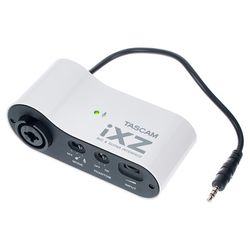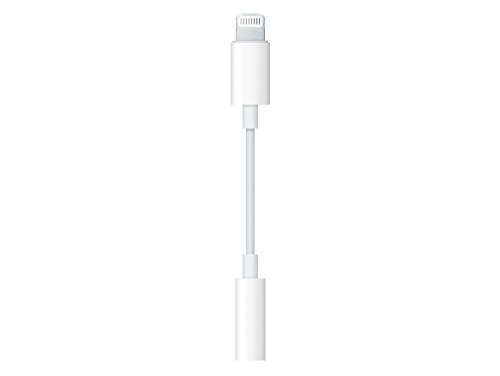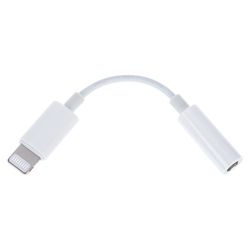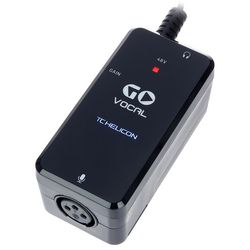Record vocals (or instruments such as guitar or keyboard) with the iPhone
At this point I would like to introduce you to a technical way how to fabricate professional-quality vocal recordings on the iPhone without complex setup. I've been fiddling around for some time to find a workable approach for me. Meanwhile, I've heard that apparently many people on the Internet are interested in a very similar solution. That's why I'm trying to summarize my setup here shortly.
The iPhone offers with the camera app a rudimentary way for video and audio recordings. If you use the Camera app to record a video you are singing on, you will find that the internal microphone is not well suited for fabricating quality music recordings. In addition, you will find that it is not possible to connect a professional microphone to the iPhone, because the iPhone has a 4-pin 3.5 mm jack, the headset and headphone jack in one unit. Professional microphones, on the other hand, can not be plugged into a standard 3.5 mm jack, but instead usually require an XLR connector, including 48V phantom power for extended power.
The easiest way to connect a professional microphone or instrument like guitar or keyboard to an iPhone is to use an audio interface like the Tascam iXZ.* This audio interface has a combined input of XLR and 1/4" jack for connecting a microphone, instrument or mixer. Thus, either an XLR microphone cable* can be plugged in or an instrument cable, as it is usually used for guitars or keyboards. In addition, there is a separate headphone jack, via which the sound output of the iPhone is transmitted. The output of the Tascam iXZ is a 4-pin jack plug that plugs directly into the iPhone. Newer iPhones use Lightning inputs instead of jack inputs. For this was the purchase of your iPhone a corresponding adapter from jack to Lightning* at, which must be plugged into the iPhone beforehand.
How do I connect a mixer to the iPhone?
Most likely, you do not just want to record your vocals or perform pure voice recordings, but also have accompaniment music to run or even play yourself. The audio interface has only a single input, but it can be preceded by a mixer to combine multiple channels.
At the mixing desk, I personally have very good experience with the universal Yamaha AG06 multi-purpose mixer* collected. It is a very small, handy mixer, but in addition to the compactness and a very low price also has an integrated effects unit with the main vocal effects Compressor, Equalizer and Hall. This allows you to make your vocals sound more professional and also connect other instruments or audio sources such as a laptop, iPod, MP3 player or CD player. For example, you can play a karaoke version of your song on YouTube via a laptop that can be connected to any input on the console using its 1/4" headphone output (3.5 mm) with a connection cable* while listening to the video Recording and singing. Alternatively, of course, an instrument such as a keyboard, stage piano or a guitar with pickup can be connected to it.
No matter if you already have a mixer or you decide for the described mixer, you can go directly from there via the main out into the audio interface. To connect the main out of the mixer to the input of the Tascam iXZ you need an instrument cable (6.35 mm jack to 6.35 mm jack).*
It should be noted at this point that the described solution is a technically rather simple solution. Of course, there are also more complex solutions that allow multi-track recordings. I have chosen the solution over the 4-pin jack input of the iPhone, since this approach is compatible with any available app on the iPhone, as it treated the input absolutely identical as if the audio information via a headset. This allows any app to be used, with the usual video and audio recordings are possible. Multi-track recordings - for example via Garage Band, Steinberg Cubase or ProTools - then enable the subsequent editing of single tracks. This is also possible in principle. However, the solution described above is rather intended as a simple authentic live recording, which is sufficient in many cases and already allows very good results, without having to deal with major technical difficulties.
For multi-track recording, the mixer can be connected to the iPhone via the USB output with a printer cable (included with the Yamaha mixer) and an Apple Camera Connection Kit.* Be sure to use the original (albeit expensive) Apple Camera Connection Kit. There are also cheap replicas. In the case of the cheap replicas, despite the good reviews, I have unfortunately had the bad experience that these may no longer be supported in later operating system versions and thus lose their functionality in the case of updates. Some do not work despite good ratings from the beginning. Alternatively, the mixer can be connected to a Mac or PC via the USB output. However, this approach requires the use of special audio sequencer software (Garage Band, Steinberg Cubase, ProTools etc.) and not every iPhone standard app is more compatible. For this solution via the Yamaha AG06 with Apple Camera Connection Kit, the Tascam iXZ audio interface is only necessary if you have to rely on every standard app on the iPhone to work with it. The iPhone camera app, for example, works fine on the Yamaha AG06 with the Apple Camera Connection Kit on the Lightning port. By contrast, for example, some versions of the Smule Karaoke app only work on the connection variant using Tascam iXZ on the 3.5 mm jack.
In addition, important
It should be noted that the Tascam iXZ is designed as a mobile device and is therefore powered by AA batteries* or equivalent batteries. These are not included in the delivery.
In addition, the Yamaha AG06 has as a cable only the USB printer cable for connection to a computer, or the Apple Camera Connection Kit to an iPhone. As a power adapter, any Android charger (ie power plug with USB socket incl. Android connection cable*) can be used - but you have to either buy separately or already have at home.
In addition, I would like to mention that some websites refer to the fact that a connection via a Y-splitter would be possible. Unfortunately, this solution did not work for me and a few others I talked to.
More questions?
If the article has not answered all questions, you can also contact me.
Note about affiliate links
*On this page, I share my personal experience with my own personal experience. If articles such as technical equipment are presented, this is not sponsoring by the manufacturer. Nevertheless, I reserve the right to put affiliate advertising links to shopping sites. In the case of product sales on the linked website, the website operator receives a small commission - of course, without the article for the buyer is thereby more expensive. Affiliate advertising links are marked with an appropriate *.
![]yamaha_ag06mk2 ]yamaha_ag06mk2](https://m.media-amazon.com/images/I/41tiKgEQwKL._SL500_.jpg)





![]tascam_ixz ]tascam_ixz](https://m.media-amazon.com/images/I/41OO01g1jOL._SL500_.jpg)



![]adapter_klinke_auf_lightning ]adapter_klinke_auf_lightning](https://m.media-amazon.com/images/I/21oM9VHgPHL._SL500_.jpg)



![]audiointerface_steinberg_ur22_mk2 ]audiointerface_steinberg_ur22_mk2](https://m.media-amazon.com/images/I/51KHG9NwYnL._SL500_.jpg)



![]adapter_apple_camera_kit ]adapter_apple_camera_kit](https://m.media-amazon.com/images/I/21vSG5ay-dL._SL500_.jpg)





![]helicon_govocal ]helicon_govocal](https://m.media-amazon.com/images/I/31jDHq69AHL._SL500_.jpg)

